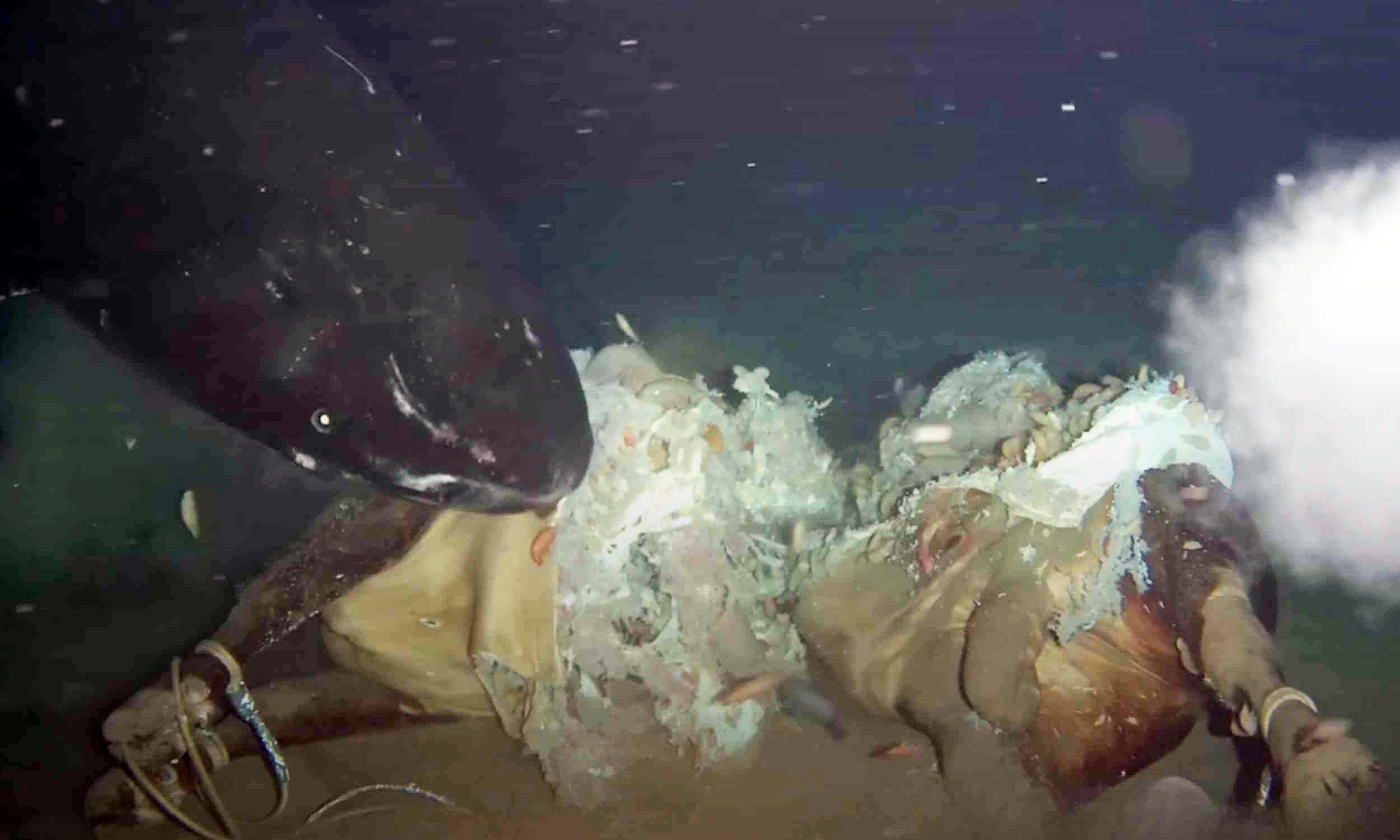Eight Pacific sleeper sharks showed up for dinner when researchers dropped a cow carcass to the seafloor of the South China Sea at 5,344 feet (1,629 meters) near Hainan Island.
The visit offered a rare observation of how these deep residents feed, wait, and make room for one another.
The species is hard to study because it ranges widely and spends much of its life in cold, dark water. Scientists struggle to track it across the North Pacific, from Japan and Alaska down to Baja California, and into a few tropical outposts.
Why put a cow on the seafloor?
A whale fall is what biologists call it when a dead whale sinks and turns the seafloor into a temporary buffet.
Research teams sometimes simulate that scene to study who arrives and how energy moves through the deep. The South China Sea team followed that playbook with cameras and a carefully placed cow.
These carcasses create waves of life that unfold in stages, starting with mobile scavengers, then opportunists, then long, slow bone feasts powered by microbes.
The point is not the species of the carcass, it is the sudden pulse of organic matter that draws in animals from far and wide.
The paper’s lead author is Han Tian of Sun Yat-sen University and the Southern Marine Science and Engineering Guangdong Laboratory.
The group partnered with the Institute of Acoustics (IOA) at the Chinese Academy of Sciences and an offshore engineering team to run the operation.
Sleeper sharks appeared unexpectedly
The sharks attacked, waited, and circled in turn, with body size shaping tactics. Individuals longer than 2.7 meters, 8.9 feet, hit the carcass directly, while smaller sharks moved carefully and held back.
They also queued in a rough order. “This behavior suggests that feeding priority is determined by individual competitive intensity, even in deep-water environments, reflecting a survival strategy suitable for non-solitary foraging among Pacific sleeper sharks,” explained Han Tian.
This was the first documented presence of Pacific sleeper sharks in the South China Sea, which expands the species’ known range in a warm basin long considered outside its core distribution.
The observation raises fair questions about how currents, food availability, or temperature structure their movements.
Past records already nudged the map south when sightings surfaced near the Solomon Islands and Palau, almost 1,250 miles below traditional range limits. Those scattered reports hinted at flexibility that formal surveys struggle to capture.
The pecking order at depth
Social rules showed up in the footage even without sound or light beyond the cameras.
Sharks yielded positions to an approaching neighbor and one animal carried a fin scar, a hint that status is negotiated with both restraint and force when necessary.
Scavenging order is not unique to this species, and researchers have documented multi-shark meals with shifting access on other large carcasses in blue water.
Field reports show oceanic whitetips and tiger sharks sharing a carcass with loose spacing and brief disputes, a pattern that mirrors what the cameras captured on the seafloor here.
The video picked up a quick eye retraction movement during feeding. That makes sense for a shark lineage that lacks a nictitating membrane, the third eyelid that many other sharks deploy as a shield.
A nictitating membrane slides across the cornea during risky moments and is common in ground sharks such as requiems and hammerheads, but not in all sharks, so animals without it rely on other defenses like rolling or retracting the eyes.
Breath and the spiracle question
Suspended particles were seen exiting the sharks’ spiracles, small openings behind the eye, which suggests these structures help route water when the mouth is busy with food.
Classic lab studies show that water can be taken in through the first gill slits to keep oxygen flowing when the mouth is obstructed, a practical workaround during feeding.
A spiracle is a modified first gill slit that, in many bottom-dwelling sharks, provides a pathway to ventilate the eye and brain while the rest of the body holds steady.
It is reduced in some fast swimmers and more prominent in species that rest on the seafloor, which fits a slow, patient hunter like a sleeper shark.
Parasites plague sleeper sharks
White, elongated copepods clung to the heads of several sharks.
Close relatives often carry eye parasites, and studies in Alaska found nearly universal infection of Pacific sleeper shark corneas by Ommatokoita elongata, with typical loads of one to two adults per infected eye.
Those parasites can scar the cornea, which makes non-visual senses even more important in the deep.
Other visitors wandered in and out of frame, including a snailfish and a crowd of amphipods with the occasional giant isopod.
The community that assembles around a carcass changes hour by hour as the meal is taken apart and the energy is spread into the sediment.
What it means for deep-sea food webs
Eight large scavengers arriving within hours means there is a network ready to respond when food drops.
That response plugs into a broader pattern in which carcasses feed mobile animals first, then fuel a long, microbial afterlife that supports worms and crustaceans for years.
The South China Sea sighting adds a piece to the puzzle of where these sharks live and how they share food.
It also shows that simple, well-designed experiments can turn a single drop into a map point, a behavior log, and a better grasp of who eats what in the dark.
The study is published in Ocean-Land-Atmosphere Research.
—–
Like what you read? Subscribe to our newsletter for engaging articles, exclusive content, and the latest updates.
Check us out on EarthSnap, a free app brought to you by Eric Ralls and Earth.com.
—–
